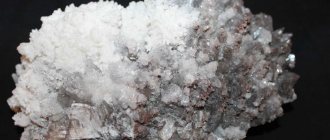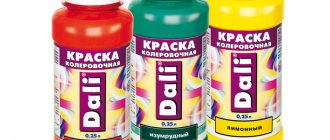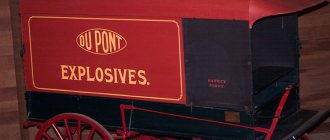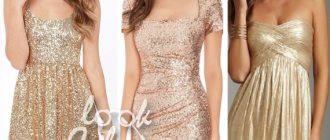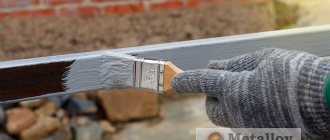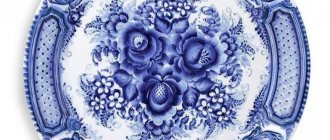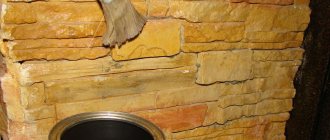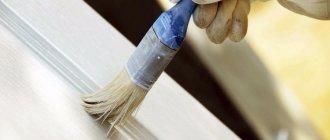Fluorescent paint is a dispersion composition containing a fluorophore pigment. Images created using this material become more voluminous, colors are brighter, and a glow occurs when exposed to ultraviolet light. Under artificial and daylight lighting, such effects do not appear on the coating.
Using fluorescent paint you can create a unique decor in any room of your home.
General information about fluorescent paint
Fluorescent paint is also called ultraviolet. Its specific properties appear only under the influence of UV radiation.
The properties of natural fluorophores have been studied since the beginning of the last century, but such compounds were unstable and quickly degraded under the influence of environmental factors.
Relatively recently, special modifiers have been developed that increase the stability of the pigment. Additives and auxiliary components slow down the process of degradation of the structure of a substance that glows under ultraviolet light. The paints are relatively safe for people and animals. This expanded the scope of application of the material.
Compound
The fluorescent paint contains the following components:
- Basic polymer base. Polyurethane and acrylic resins are most often used.
- Fluorophore. A pigment made from aminophthalimide or rhodamine.
- Ultraviolet modifiers. Complex substances that prevent dye fading.
- Binders and fillers. Auxiliary components that stabilize the composition and ensure sufficient viscosity.
Properties
Fluorescent paints have high light reflectivity, which reaches 150-300%. Glow occurs when ultraviolet rays hit the coating. This effect is absent in the dark. The material has neon shades. This is due to the characteristics of the pigment.
Without special additives and modifiers, the fluorophore structure quickly degrades, losing its properties. The pigment has low resistance to high temperatures. When heated strongly, it disintegrates and its ability to glow in ultraviolet light decreases.
Operating principle
The fluorophore is often made from rhodamine. This is an expensive substance, so in its pure form it is almost never used for paints. To reduce the price, the pigment is made by staining small particles of a polymer dispersion with a fluorophore. The substance is not able to accumulate energy in daylight, like phosphorus molecules. It reflects and amplifies the rays. This effect provides the characteristic glow of the coating in ultraviolet light.
Fluorescent paints require the use of an ultraviolet lamp, which will highlight the painting they make.
Benefits of use
The advantages of fluorescent paint include:
- High brightness of the finished coating.
- Continuous glow under ultraviolet light.
- No pungent odor.
- Low fire hazard.
- Economical consumption.
- Resistance of the coating to the influence of water.
The material belongs to hazard class 4, i.e. it does not release toxic substances into the air and can be used for finishing indoor surfaces.
Why do these coatings glow?
A special pigment provides the glow of fluorescent paint; The fluorophore converts and transmits the ultraviolet rays it absorbs into the visible part of the spectrum.
Fluorophores are usually represented by substances such as rhodamines, as well as aminonaphthalimide derivatives. Since these components are too expensive in their pure form, they paint the smallest particles of a polymer dispersion, obtaining that special, fluorescent pigment that is added to the base of the material during paint production.
Such a coating is not capable of absorbing and storing light, unlike luminescent paints that glow in the dark without any external influence. They contain another active substance - a phosphor, and these paints are otherwise called neon. Fluorescents only reflect the rays of the sun or the light of ultraviolet lamps.
Differences from fluorescent
Fluorescent and luminescent paint are significantly different. In the production of the latter, pigments are used - phosphors. These substances accumulate energy from sunlight and glow in the dark even without additional sources of UV radiation. The effect lasts up to 12 hours. Residual effects are observed for up to 2 days.
Luminescent and fluorescent paints differ from each other in the pigment contained in the composition.
However, when the coating remains in the dark for a long time, the intensity of the glow gradually decreases, so regular replenishment is required. The particle size of the fluorophore pigment is 75 microns, and the phosphor is only 5 microns, so paints based on the latter are suitable if you need to get a smooth and even surface.
Main types
Fluorescent compositions differ in the type of base, the inclusion of auxiliary additives and the release form. These parameters affect the scope of application.
Acrylic based
Water-acrylic compositions resemble watercolor in consistency. They are often used to create complex designs on leather, cardboard, paper, wood, plaster and some other materials.
You cannot apply designs with this composition on glass, metal and plastic.
The acrylic base, into which the fluorescent pigment was introduced, does not have a strong odor and dries quickly. The only obvious drawback of this composition is its low resistance to water.
Acrylic fluorescent paints dry quickly and are very economical.
Polyurethane enamel
Fluorescent polyurethane enamels are used for interior and exterior decoration. The properties of the material do not decrease with changes in environmental humidity, temperature changes and the influence of other environmental factors. Polyurethane fluorescent enamel has high adhesion. It can be used for walls, floors and ceilings. The finished coating is durable and abrasion resistant.
Fluorescent ink
Fluorescent inks are now produced for large-format, laser and inkjet printers. Such compositions are used to apply luminous inscriptions on various surfaces.
Invisible paints
These paints have a transparent base. When applied to a surface during the daytime, they are almost invisible. On white surfaces they are not visible, but on dark ones a white film appears. They produce “invisible” paint in red, blue, purple, green, etc. The beauty of the finished coating is revealed only in ultraviolet rays.
Invisible paints are practically invisible on light-colored surfaces during the day.
Facade
Fluorescent acrylic compounds are classified into a separate group. They contain a high content of modifiers, so they have increased resistance to abrasion, humidity and temperature changes. The composition has high adhesion to most substrates. Strong detergents can be used to clean painted surfaces.
The specific properties of facade acrylic paints include absence of odor and high permeability.
Alkyd in aerosol cans
A separate group includes fluorescent aerosols containing alkyd and urethane. The spray form makes application easy. It is often used in airbrushing.
Powder
Powder pigment combines well with enamels and varnishes of various chemical compositions. It is used when it is necessary to obtain a composition with increased performance characteristics. Powder fluorophores are often used to coat car bodies.
Fluorescent powder paint differs from regular paint by the addition of special pigments.
Paint application technology
To create a coating on a wall or any other object, several important conditions must be met:
There should be no dust or moisture on the surface to be treated. Dark and black areas are pre-primed or painted white.
When a transparent dye is applied to a colored surface, the spectral transformation of the UV rays changes. To obtain an accurate color, the substrate is bleached.
There should be no dust or moisture on the surface to be treated.
Surface preparation
Before painting, the surface is washed, the old coating is removed, clean objects must be degreased using solvents, then washed and dried well so that no traces of moisture remain.
Before painting, the surface is washed, the old coating is removed, and clean objects must be degreased.
Coloring
Fluorescent paint or enamel is applied with a brush, spray gun or roller. To paint small objects of complex shape, use a sponge or cuvette. Thickened compositions are pre-diluted to the consistency of liquid sour cream. Before applying paintwork materials, be sure to mix them.
When using stencils, the borders are glued with masking tape. Two-layer coatings are applied in perpendicular directions.
Fluorescent paint or enamel is applied with a brush, spray gun or roller.
When choosing a coating, it is important to know exactly what the luminous paint is called. Traditional fluorescent bright green color goes well with yellow and orange. You can create compositions that glow in the UV spectrum on facades, bodies, and walls.
Color variety
The palette is limited to a small number of shades. Manufacturers often produce formulations in the following colors:
- yellow;
- blue;
- purple;
- green;
- orange;
- white;
- red;
- pink;
- lemon
Paints are divided into chromatic and achromatic. Species belonging to the first category glow only due to ultraviolet rays. Achromatic compositions can transform dull tones into bright ones.
The color palette of fluorescent paint is represented by a small number of colors.
DIY glowing paint
It turns out that it’s not at all difficult to make luminous paint yourself. This requires a very simple set of ingredients.
DIY glowing paint at home
Stages.
- So, we buy boric acid and pine powder concentrate at the pharmacy. Next, dilute the powder in a small amount of water. A yellow mixture called tartazine is formed.
- The next step is to add boric acid to the resulting mixture, about a third of a spoon, the result will be a sour cream-like mass, homogeneous in composition.
- Now we begin to heat the resulting mass. Be sure to stir; bubbles will form during the process, which must be removed by piercing. The mixture will turn pale yellow.
- Cool it and add more tartazine. Continue heating, remembering to constantly stir the mixture.
- The result should be a bright yellow powder - a phosphor. By dissolving it in water, varnish, paint, we get luminous paint. A surface painted with this composition will glow in the dark.
Areas of use
Paints with fluorescent properties have become more accessible, so the scope of their application is constantly expanding.
Outside the home
Outdoors, only compounds that are resistant to environmental factors are used. Such paints are often used when decorating:
- graffiti on houses;
- billboards;
- road signs, indicators and markings;
- airbrushing;
- facades of restaurants and night clubs;
- private houses;
- signs for shops and cafes.
At home
Paints with a fluorescent effect are used to decorate walls and multi-level ceilings. This finishing material is often used to paint surfaces in children's rooms. It is used to a limited extent in the styling and restoration of furniture.
Glowing paint is used to decorate walls and ceilings.
Handmade
Paintings are painted with luminous colors. Some craftsmen use the material to create garlands and Christmas tree decorations. Keychains, figurines, dolls and other items are decorated with fluorescent compounds. Floats and other fishing accessories are often treated with enamel.
Body painting
Fluorescent acrylic paints with the addition of linolin and glycerin are used in body painting. They are used at children's parties and themed parties. Luminous compositions are used when applying temporary tattoos and face painting. If necessary, the pattern on the body can be easily washed off with water. Such compositions are harmless, but before applying them to the skin, an allergy test should be performed. This is especially important if you plan to use them during children's parties.
Other areas
Nowadays, fluorescent paints are used in the textile industry to create images on clothing, as well as patterns on curtains, bed linen, etc. Often, luminous compositions are used to illuminate various objects during parties. Such paints are widely used in the film industry.
Fluorescent paints are used to create souvenirs.
Features of use
Before applying the material, it is important to prepare the surface. The following tools will be required:
- brushes;
- sponge;
- spray;
- putty knife;
- paint roller;
- spirit level;
- spray gun, etc.
Only after this can you begin to design the surface.
Preparing the surface for painting
Preparing walls, ceilings and floors for further painting includes the following steps:
- Removal of old coating, incl. peeling varnish, plaster, whitewash, etc.
- Removing dust and dirt using washing powder, soda, ammonia solution or other cleaning agents.
- Carefully level the walls and ceiling with new plaster.
- Prime the surfaces and apply a quick-drying, light-colored varnish base.
Application rules
The paint composition is harmless, but before working with it you should wear gloves, goggles and protective clothing. This is especially important when using an aerosol. The pigment often weighs more than the base, so you need to shake the container thoroughly before use.
You can create complex images and patterns using both brushes and stencils. The paint is applied in several layers. Each of them should be allowed to dry. An additional coat of clear varnish may be required to matt the surface.
Coloring
In application, fluorescent acrylic paints are practically no different from similar compositions without a “magic” pigment. If we are not talking about an aerosol, then the following tools will be required:
- brushes,
- paint roller,
- tray,
- You can also use a spray gun.
Fluorescent dyes are usually applied in two layers. The more layers, the brighter the glow effect will be. The time interval between staining should be at least three hours. Complete drying occurs within a day.
The coloring agent must be stored in a tightly closed container, so the best option for long-term storage is paint in cans.


